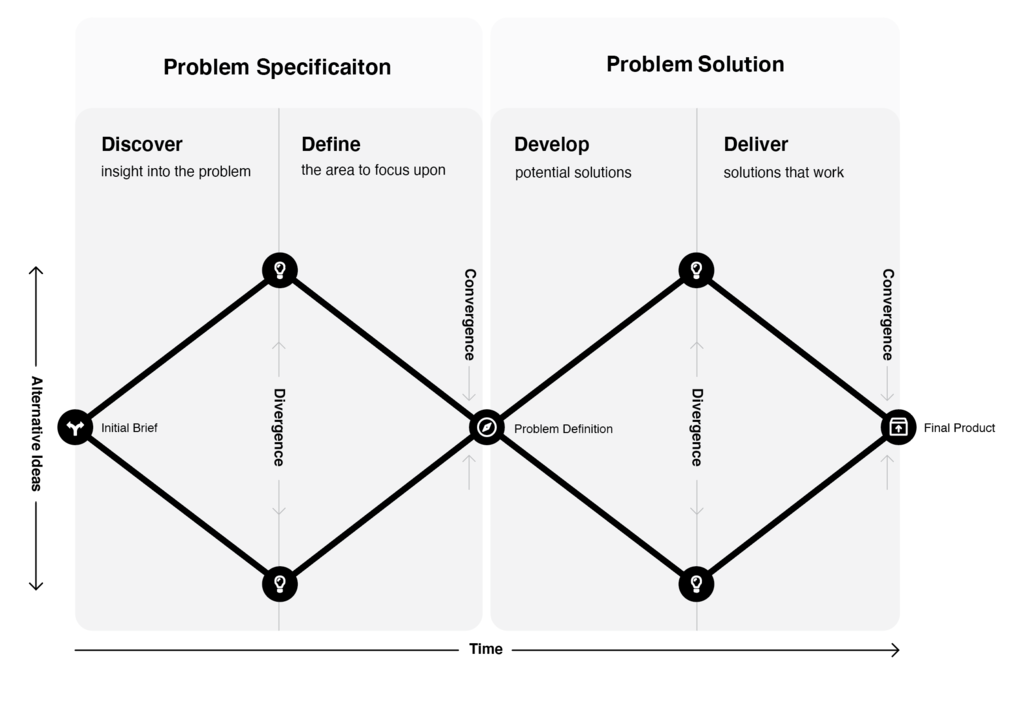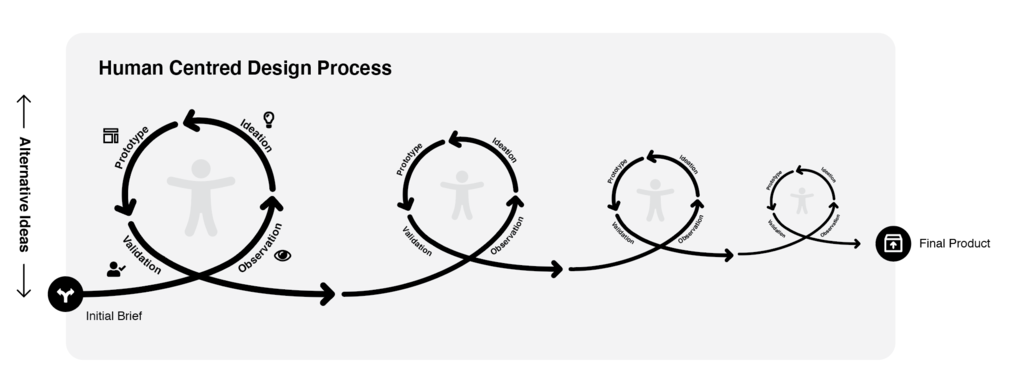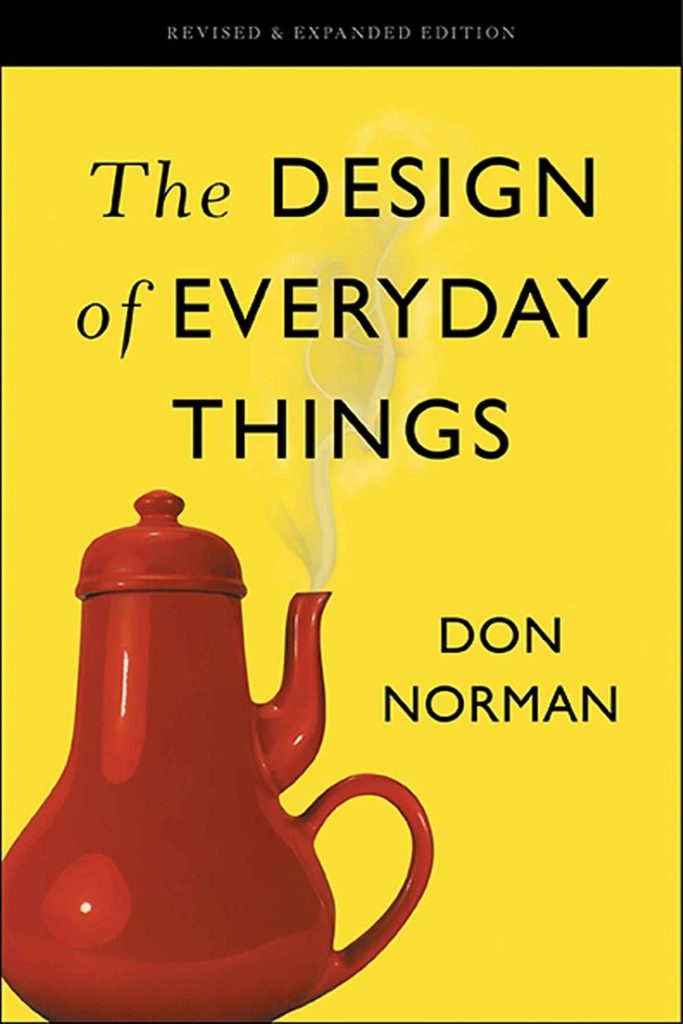“The real world is not like university .. In the real world, problems do not come in nice, neat packages; they have to be discovered” and they have to be questioned so you not only know where a problem came from but that you’re solving the right problem.
In this chapter, Norman discusses the processes that can be employed to not only find the right problem (using the double-diamond model) but also derive the right solution (using the human-centred design process). Used together, these processes help designers understand what the real issues are and then develop solutions and results that fit the desires, needs, and capabilities of the people who will be using them (target audience/market/populations).
These methodology frameworks move away from the traditional linear design process (sometimes referred to as waterfall methods). Instead the double-diamond and human-centred design processes (sometimes referred to as agile or scrum) establish iterative and expansive workflows that cycle between exploratory and consultative states, emulating an evolutionary process where many approaches are explored, only to be narrowed down to the ‘fittest’ solutions. In this mind, designers try to learn from the process before attempting to develop solutions to a problem; even the initial brief is free game as new learnings inform the designer’s framing of a problem. The “process is circular, with continual refinement, continual change, and encouragement of backtracking and rethinking of early decisions”.
The underlying theory of the these methodologies is to “solve the right problems and do so in a way that meets human needs and capabilities”. The design process can be quite complicated, needing to satisfy a broad range of constraints and concerns, including: “shape and form, cost and efficiency, reliability and effectiveness, understanding and usability, pleasure and appearance, pride of ownership, and the joy of actual use”; the double-diamond and HCD processes give us a means through which to address all of these in an iterative and replicable process.
Double-Diamond Model of Design

Proposed by the British Design Council in the mid-2000s, the ‘double-diamond design process model’ created a framework of principles and procedures that could be followed to “properly determine the right problem to be solved and the the best way to solve it”. It is divided into two phases, Phase one is for determining the scope of the problem space while Phase two explores solutions to the determined problem. Both phases are divided into two subsequent stages of divergent and convergent thinking; first inviting questioning/exploration of the task at hand and then narrowing the fruits of this process to the most suitable candidates.
During the Problem phase, these are the Discover (Divergent) and Define (Convergent) stages which allow designers to find the right problem by first exploring alternatives and then narrowing them down. During the Solution phase, these stages are known as the Develop (Divergent) and Deliver (Convergent) stages that help designer develop the right solutions to the problem by first exploring different approaches and then selecting the most suitable.
Human Centred Design Process

The Double-Diamond Model establishes the framework for determining the right problem and then solving it in the best way. A part of that divergent (Discover & Develop) and convergent (Define & Deliver) process is to observe, ideate, prototype, and validate our designs in a meaningful way; thats where the Human-Centred Design process comes in. The Human-Centred Design process is part of the Double-Diamond model and gives us the practical activities we need to evolve our designs. Its an iterative and cyclical process (like a spiral) that is repeated over and over again to gradually refine the design and bring it closer to its resolved form.
The process consists of four five activities:
1. Observation – Make observations on the intended target population
Understanding comes from knowledge and we can gather knowledge through observation. As mentioned at the beginning of this summary, real life is not like university, it is not a controlled environment where our assumptions are always true. Instead, real life is full of unexpected approaches, chance encounters, and sometimes even contradictory positions. For this reason, it’s important for us to first observe/listen before we act. Applying a technique called ‘applied ethnography’ designers will ‘follow’ potential would-be customers as to “observe their activities, attempting to understand their interests, motives, and true needs.” This is achieved by observing these future “customers in their natural environment, in their normal lives, where-ever the product or service will actually be used”. The people being observed should match the intended audience/target population for the product; sometimes its useful to group these into traditional demographics of sex, age, education, and income but its always useful to observe the actions being performed. People from different backgrounds and cultures are.. well.. different, whats the same is the activities they are trying to perform – this is why computers and cars more or less look the same all around the world.
“Design research supports both diamonds of the design process. The first diamond, finding the right problem, requires deep understanding of the true needs of people. Once the problem has bee defines, finding an appropriate solution again requires deeps understanding of the intended populations, how those people perform their activities, their capabilities and prior experience”
As opposed to market research, which wants to know what people will buy, design research “wants to know what people really need and how they will use the product or service under consideration”. For this, qualitative observational methods are used, study a few people indepth to gain a comprehensive understanding of how they go about their activities and the environmental context they do these in. These methods are very time consuming, so typically only a handful of people will be observed – often only in the tens. Both Design and market research are important in bringing a new product into existence – theres no point to good design if no one will buy it, similarly, theres no point to marketing something that doesn’t work, both are pieces of the same pie in making a successful product.
2. Ideation – Generate Ideas and hypothesis based on observations
At the divergent stages of the double-diamond framework (Discover & Develop), idea generation facilitates a broad consideration of possibilities, both in what problems to solve and then how to solve them. There are lots of creative techniques for spurring ideas, Norman outlines the underlying principles for these as being:
– Generating many ideas – without fixating on one or two ideas early in the process.
– Being creative without constraints – avoid passing judgement on ideas – either your own or others. Radical and crazy ideas are good because they expand the frame of possibility and in the process, create creative insights that can benefit the ideation process overall. So avoid criticising ideas until you have to.
– Question everything & ask stupid questions – our preconceived assumptions about our world cloud our ability to reframe our view on something, asking questions helps us challenge this, especially stupid questions. ‘when [stupid] questions are take seriously, they are often profound: the obvious is often not obvious at all’. “Quite often the solution to a problem is discovered through stupid questions, [by] questioning the obvious:”
3. Prototype – produce experiments based on hypothesis
“The only way to really know whether an idea is reasonable is to test it.”
A prototype is a way of rendering an idea in the real world and seeing how it works. Prototypes can be both crude mockups at the beginning of the process and they can be high-fidelity renditions of a near-final version of the design. The idea is to have something, anything, to validate the hypothesis you’ve formulated from your observations. This includes early paper sketches or cardboard mockups of each potential solution, they can even be skits that play out interactions (i.e. when designing services). They can even fake the functionality of a design using wizard of oz techniques where things seem to be working on the front end but are actually manually controlled on the backend. Prototyping ideas in this way gives us a means through which to validate them in a way that explaining them would never be able to do. Being able to hold, touch, interact with an idea is much more powerful, people just get it. Its why professions such as architecture use physical models to showcase their designs, something happens in our brains when we see things in the real world.
4. Validation – test experiments on target populations
Once we have a prototype, it’s time to test and validate it. This stage is an opportunity to study and observe how our hypothesis and assumptions about how something will be used stack up against a real-world use case. By gathering a small group of people (usually about five for each prototype iteration) for whom the product is intended for, we can get an insight to things that work, things that don’t, and how someone interprets a design with fresh eyes. It’s important that these people match the target audience/population for the product as closely as possible; the idea is to emulate the real world in this test to learn as much as possible. Typically, validating a design with five people gives us all the data we need to refine and retest an idea with a new group of people, this way a design can be quickly refined and tuned.
Ways of testing an idea include observing individuals use the prototype, having pairs of people use and verbalise their actions, and interviewing users after they use a prototype to learn about their experience. Filming these interactions for future reference can be useful too.
5. Repeat – Iterate through process until satisfied.
“Fail frequently, fail fast” -David Kelly, Co-founder IDEO
“The hardest part of design is getting the requirements right, which means ensuring that the right problem is being solved, as well as that the solution is appropriate. Requirements made in the abstract are invariably wrong. Requirements produced by asking people what they need are invariably wrong. Requirements are developed by watching people in their natural environment”
A big part of the Human-Centred Design process is continual refinement and enhancement. This is achieved by first observing and studying what the problem might be, deriving insights from tests about what works and what doesn’t, and then repeating the process.
“With each cycle, the tests and observations can be more targeted and more efficient. With each cycle of the iteration, the ideas become clearer, the specifications better defined, and the prototypes closer approximations to the target, the actual product”
“After the first few iterations, it is time to start converging upon a solution. The several different prototype ideas can be collapsed into one.”

Chapter 6. Notes from Reading:
The Design of Everyday Things: Revised and Expanded Edition By Don Norman
